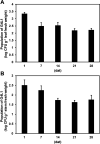Biocontrol of Tomato Bacterial Wilt by Foliar Spray Application of a Novel Strain of Endophytic Bacillus sp
- PMID: 33012743
- PMCID: PMC7734409
- DOI: 10.1264/jsme2.ME20078
Biocontrol of Tomato Bacterial Wilt by Foliar Spray Application of a Novel Strain of Endophytic Bacillus sp
Abstract
The aim of the present study was to identify a strain of endophytic Bacillus species that control tomato bacterial wilt by foliar spray application. Fifty heat-tolerant endophytic bacteria were isolated from the surface-sterilized foliar tissues of symptomless tomato plants that had been pre-inoculated with the pathogen Ralstonia pseudosolanacearum. In the primary screening, we assessed the suppressive effects of a shoot-dipping treatment with bacterial strains against bacterial wilt on tomato seedlings grown on peat pellets. Bacillus sp. strains G1S3 and G4L1 significantly suppressed the incidence of tomato bacterial wilt. In subsequent pot experiments, the biocontrol efficacy of foliar spray application was examined under glasshouse conditions. G4L1 displayed consistent and significant disease suppression, and, thus, was selected as a biocontrol candidate. Moreover, the pathogen population in the stem of G4L1-treated plants was markedly smaller than that in control plants. A quantitative real-time PCR analysis revealed that the foliar spraying of tomato plants with G4L1 up-regulated the expression of PR-1a and LoxD in stem and GluB in roots upon the pathogen inoculation, implying that the induction of salicylic acid-, jasmonic acid-, and ethylene-dependent defenses was involved in the protective effects of this strain. In the re-isolation experiment, G4L1 efficiently colonized foliar tissues for at least 4 weeks after spray application. Collectively, the present results indicate that G4L1 is a promising biocontrol agent for tomato bacterial wilt. Furthermore, to the best of our knowledge, this is the first study to report the biocontrol of bacterial wilt by the foliar spraying with an endophytic Bacillus species.
Keywords: Ralstonia pseudosolanacearum; biological control; endophytic Bacillus; foliar spray; induced systemic resistance.
Figures






Similar articles
-
Endophytes from Gnetum gnemon L. can protect seedlings against the infection of phytopathogenic bacterium Ralstonia solanacearum as well as promote plant growth in tomato.Microbiol Res. 2020 Sep;238:126503. doi: 10.1016/j.micres.2020.126503. Epub 2020 May 16. Microbiol Res. 2020. PMID: 32497966
-
Evaluation of seed associated endophytic bacteria from tolerant chilli cv. Firingi Jolokia for their biocontrol potential against bacterial wilt disease.Microbiol Res. 2021 Jul;248:126751. doi: 10.1016/j.micres.2021.126751. Epub 2021 Mar 24. Microbiol Res. 2021. PMID: 33839507
-
Potential Use of L-arabinose for the Control of Tomato Bacterial Wilt.Microbes Environ. 2020;35(4):ME20106. doi: 10.1264/jsme2.ME20106. Microbes Environ. 2020. PMID: 33087626 Free PMC article.
-
Recent trends in control methods for bacterial wilt diseases caused by Ralstonia solanacearum.Microbes Environ. 2015;30(1):1-11. doi: 10.1264/jsme2.ME14144. Epub 2015 Mar 26. Microbes Environ. 2015. PMID: 25762345 Free PMC article. Review.
-
Prospects of endophytic fungal entomopathogens as biocontrol and plant growth promoting agents: An insight on how artificial inoculation methods affect endophytic colonization of host plants.Microbiol Res. 2018 Dec;217:34-50. doi: 10.1016/j.micres.2018.08.016. Epub 2018 Aug 31. Microbiol Res. 2018. PMID: 30384907 Review.
Cited by
-
Combined transcriptomic and metabolomic analysis of the mechanism by which Bacillus velezensis induces resistance to anthracnose in walnut.Front Microbiol. 2024 Oct 9;15:1420922. doi: 10.3389/fmicb.2024.1420922. eCollection 2024. Front Microbiol. 2024. PMID: 39444687 Free PMC article.
-
The Role of Endophytes in Combating Fungal- and Bacterial-Induced Stress in Plants.Molecules. 2022 Oct 3;27(19):6549. doi: 10.3390/molecules27196549. Molecules. 2022. PMID: 36235086 Free PMC article. Review.
-
In Vivo Endophytic, Rhizospheric and Epiphytic Colonization of Vitis vinifera by the Plant-Growth Promoting and Antifungal Strain Pseudomonas protegens MP12.Microorganisms. 2021 Jan 23;9(2):234. doi: 10.3390/microorganisms9020234. Microorganisms. 2021. PMID: 33498710 Free PMC article.
-
The role of Bacillus species in the management of plant-parasitic nematodes.Front Microbiol. 2025 Jan 17;15:1510036. doi: 10.3389/fmicb.2024.1510036. eCollection 2024. Front Microbiol. 2025. PMID: 39895938 Free PMC article. Review.
-
Identification of Fusarium oxysporum f. sp. melonis Race 2 in Central Taiwan and Its Potential Biocontrol Agent.Plant Pathol J. 2025 Jun;41(3):352-366. doi: 10.5423/PPJ.OA.01.2025.0012. Epub 2025 Jun 1. Plant Pathol J. 2025. PMID: 40468882 Free PMC article.
References
-
- Alippi A.M., Perelló A.E., Sisterna M.N., Greco N.M., and Cordo C.A. (2000) Potential of spore-forming bacteria as biocontrol agents of wheat foliar diseases under laboratory and greenhouse conditions. J Plant Dis Prot 107: 155–169.
-
- Artal R.B., Gopalakrishnan C., and Thippeswamy B. (2012) An efficient inoculation method to screen tomato, brinjal and chilli entries for bacterial wilt resistance. Pest Management In Horticultural Ecosystems 18: 70–73.
MeSH terms
Supplementary concepts
LinkOut - more resources
Full Text Sources
Molecular Biology Databases
Research Materials

